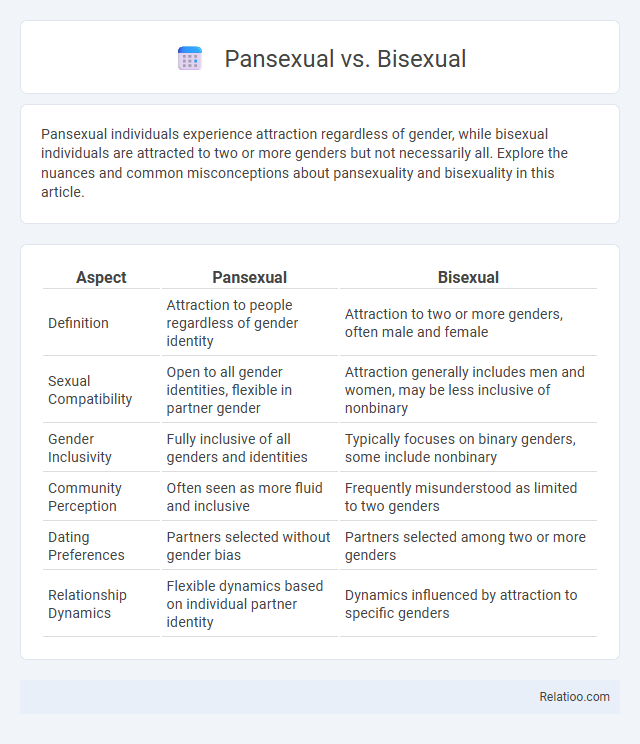Pansexual individuals experience attraction regardless of gender, while bisexual individuals are attracted to two or more genders but not necessarily all. Explore the nuances and common misconceptions about pansexuality and bisexuality in this article.
Table of Comparison
| Aspect | Pansexual | Bisexual |
|---|---|---|
| Definition | Attraction to people regardless of gender identity | Attraction to two or more genders, often male and female |
| Sexual Compatibility | Open to all gender identities, flexible in partner gender | Attraction generally includes men and women, may be less inclusive of nonbinary |
| Gender Inclusivity | Fully inclusive of all genders and identities | Typically focuses on binary genders, some include nonbinary |
| Community Perception | Often seen as more fluid and inclusive | Frequently misunderstood as limited to two genders |
| Dating Preferences | Partners selected without gender bias | Partners selected among two or more genders |
| Relationship Dynamics | Flexible dynamics based on individual partner identity | Dynamics influenced by attraction to specific genders |
Understanding Sexual Orientation: Definitions Matter
Understanding sexual orientation involves recognizing distinct identities such as pansexual, bisexual, and other orientations that relate to attraction patterns. Pansexual individuals experience attraction regardless of gender, while bisexuality typically denotes attraction to two or more genders, often male and female. Your awareness of these definitions enhances empathy and supports inclusive conversations about sexual diversity.
What Does Pansexual Mean?
Pansexual refers to a sexual orientation characterized by attraction to individuals regardless of their gender identity or biological sex, emphasizing the inclusivity of all gender spectrums. Unlike bisexuality, which traditionally denotes attraction to two or more genders but often centers on male and female genders, pansexuality explicitly rejects the gender binary altogether. Sexual orientation broadly describes a person's enduring pattern of romantic or sexual attraction to others, and pansexuality represents one of the many nuanced identities within this spectrum.
What Does Bisexual Mean?
Bisexual refers to a sexual orientation where an individual experiences attraction to more than one gender, typically both male and female. This term emphasizes the capacity for emotional, romantic, or sexual attraction to multiple genders, without limiting such attraction to a single gender identity. Understanding bisexuality helps clarify distinctions from other orientations like pansexuality, which involves attraction regardless of gender, highlighting the diversity within sexual orientations.
Key Differences Between Pansexual and Bisexual
Pansexual individuals experience attraction to people regardless of gender, emphasizing a broad and inclusive spectrum beyond the gender binary. Bisexuality typically involves attraction to two or more genders, often understood as attraction to both men and women but can include non-binary identities as well. The key difference lies in pansexuality's explicit inclusion of all gender identities, while bisexuality generally focuses on attraction to multiple genders without necessarily encompassing every identity.
Common Misconceptions and Stereotypes
Pansexuality is often misunderstood as simply being attracted to everyone indiscriminately, but it actually emphasizes attraction regardless of gender, distinct from bisexuality which involves attraction to two or more genders, typically male and female. Bisexual individuals frequently face stereotypes that their attraction is phase-based or confused, while pansexuality is sometimes inaccurately linked exclusively to non-binary or gender-nonconforming people. Sexual orientation encompasses a wide spectrum far beyond these labels, and common misconceptions undermine the complexity and validity of individual experiences within pansexual and bisexual identities.
The Role of Gender Identity in Attraction
Pansexuality involves attraction to individuals regardless of their gender identity, emphasizing a fluid and inclusive approach that transcends traditional gender binaries. Bisexuality typically refers to attraction to two or more genders, often recognizing both male and female identities but may also include other gender experiences. Sexual orientation broadly encompasses patterns of attraction that integrate or respond to gender identity, shaping how individuals experience and express desire in diverse and personalized ways.
Personal Identity and Label Preferences
Pansexuality and bisexuality both represent sexual orientations defined by the attraction to multiple genders, but pansexual individuals often emphasize attraction regardless of gender, while bisexuality typically refers to attraction to two or more genders. Your personal identity plays a crucial role in choosing a label that best reflects your experience and feelings, as these terms serve as tools for self-expression and community connection. Sexual orientation is deeply personal, and respecting label preferences fosters understanding and supports individuals in embracing their authentic selves.
Why Language and Labels Evolve
Language and labels around pansexual, bisexual, and sexual orientation evolve to better capture the complexity and diversity of human attraction and identity. Your understanding deepens as these terms shift to be more inclusive, reflecting nuanced experiences beyond binary or traditional categories. This evolution supports clearer communication and validation of individual identities within the LGBTQ+ community.
Pansexual and Bisexual Representation in Media
Pansexual and bisexual representation in media remains limited but is gradually increasing, with pansexual characters often portrayed as embracing attraction beyond gender, while bisexual characters typically face invisibility or stereotypes. This growing visibility helps challenge misconceptions about sexual orientation, highlighting the fluidity and spectrum of human attraction. Enhanced representation promotes understanding and acceptance, providing more inclusive narratives that reflect diverse experiences within the LGBTQ+ community.
Supporting Inclusion Within the LGBTQ+ Community
Pansexuality refers to attraction to people regardless of their gender identity, emphasizing inclusivity beyond traditional gender binaries, while bisexuality involves attraction to two or more genders, often encompassing both similar and different genders from one's own. Both identities highlight the spectrum of sexual orientation, underscoring the importance of recognizing diverse experiences within the LGBTQ+ community. Supporting inclusion means respecting each individual's self-identification and fostering environments where all sexual orientations are validated and celebrated.

Infographic: Pansexual vs Bisexual
 relatioo.com
relatioo.com